Chapter: 11th Botany : Chapter 6 : Cell: The Unit of Life
Difference between plant and animal cells
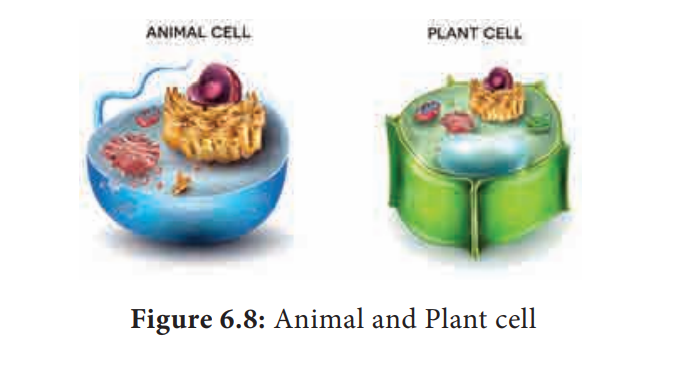
Plant and Animal cell
Difference between plant and animal cells
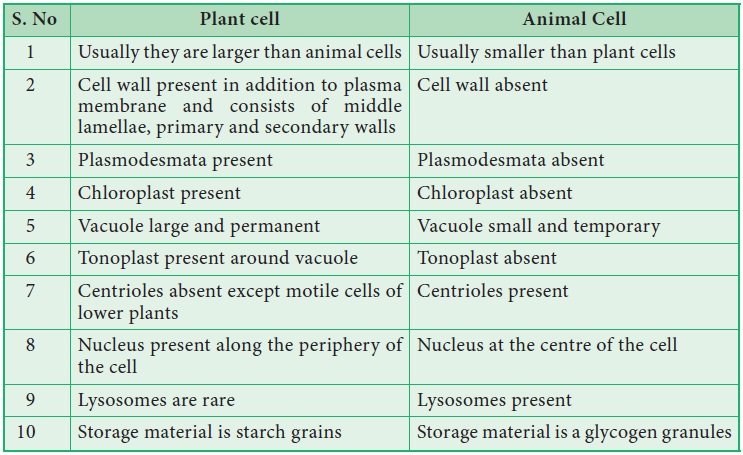
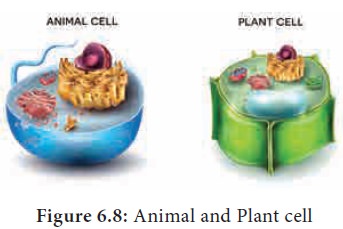
1. Ultra Structure of Eukaryotic Cell
The eukaryotic cell is highly distinct in its
organisation. It shows several variations in different organisms. For instance,
the eukaryotic cells in plants and animals vary greatly (Figure 6.8).
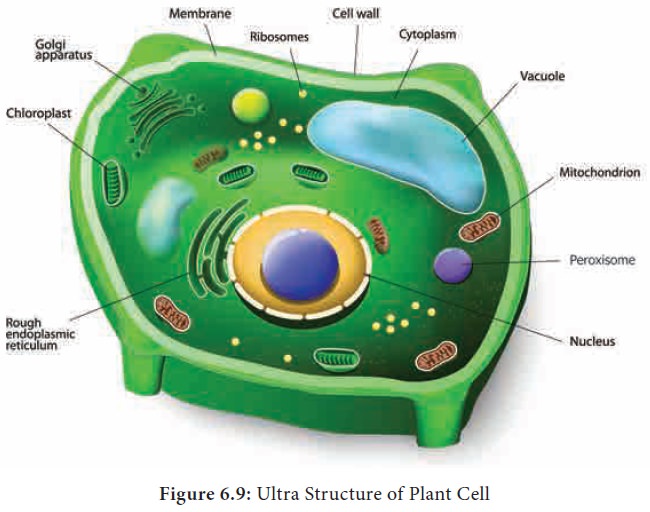
Animal Cell
Animal cells are surrounded by cell membrane or
plasma membrane. Inside this membrane the gelatinous matrix called protoplasm is seen to contain nucleus
and other organelles which include the endoplasmic reticulum, mitochondria,
golgi bodies, centrioles, lysosomes, ribosomes and cytoskeleton.
Plant cell
A typical plant cell has prominent cell wall, a
large central vacuole and plastids in addition to other organelles present in
animal cell (Figure 6.9 and 6.10).
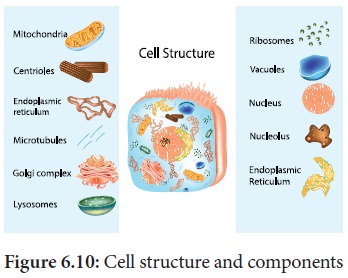
2. Protoplasm
Protoplasm is the living content of the cell that
is surrounded by plasma membrane. It is a colourless material that exists
throughout the cell together with the cytoplasm, nucleus and other organelles.
Protoplasm is composed of a mixture of small particles, such as ions, amino
acids, monosaccharides, water, macromolecules like nucleic acids, proteins,
lipids and polysaccharides. It appears colourless, jelly like gelatinous,
viscous elastic and granular. It appears foamy due to the presence of large
number of vacuoles. It responds to the stimuli like heat, electric shock,
chemicals and so on.

3. Cell Wall
Cell wall is the outermost protective cover of the cell. It is present in bacteria, fungi and plants whereas it is absent in animal cell. It was first observed by Robert Hooke. It is an actively growing portion. It is made up of different complex material in various organism. In bacteria it is composed of peptidoglycan, in fungi chitin and fungal cellulose, in algae cellulose, galactans and mannans. In plants it is made up of cellulose, hemicellulose, pectin, lignin, cutin, suberin and silica.
In plant, cell wall shows three
distinct regions (a) Primary wall (b) Secondary wall (c) Middle lamellae
(Figure 6.11).
a. Primary wall
It is the first layer inner to middle lamellae,
primarily consisting of loose network of cellulose microfibrils in a gel
matrix. It is thin, elastic and extensible. In most plants the microfibrils are
made up of cellulose oriented differently based on shape and thickness of the
wall. The matrix of the primary wall is composed of hemicellulose, pectin,
glycoprotein and water. Hemicellulose binds the microfibrils with matrix and
glycoproteins control the orientation of microfibrils while pectin serves as
filling material of the matrix. Cells such as parenchyma and meristems have
only primary wall.
b. Secondary wall
Secondary wall is laid during maturation. It plays
a key role in determining the shape of a cell. It is thick, inelastic and is
made up of cellulose and lignin. The secondary wall is divided into three
sublayers termed as S1, S2 and S3 where the
cellulose microfibrils are compactly arranged with different orientation
forming a laminated structure and the cell wall strength is increased.
![]()
![]()
![]()
c. Middle lamellae
It is the outermost layer made up of calcium and
magnesium pectate, deposited at the time of cytokinesis. It is a thin amorphous
layer which cements two adjacent cells. It is optically inactive (isotropic).
Plasmodesmata and Pits
Plasmodesmata act as a channel between the protoplasm of adjacent cells through which many substances pass through. Moreover, at few regions the secondary wall layer is laid unevenly whereas the primary wall and middle lamellae are laid continuously such regions are called pits. The pits of adjacent cells are opposite to each other. Each pit has a pit chamber and a pit membrane. The pit membrane has many minute pores and thus they are permeable. The pits are of two types namely simple and bordered pit.
Functions of cell wall
The cell wall plays a vital role in holding several
important functions given below
1) Offers
definite shape and rigidity to the cell.
2) Serves as
barrier for several molecules to enter the cells.
3) Provides
protection to the internal protoplasm against mechanical injury.
4) Prevents
the bursting of cells by maintaining the osmotic pressure.
5) Plays a
major role by acting as a mechanism of defense for the cells.
4. Cell Membrane
The cell membrane is also called cell surface (or) plasma membrane.
It is a thin structure which holds
the cytoplasmic content called ‘cytosol’.
It is extremely thin (less than 10nm).
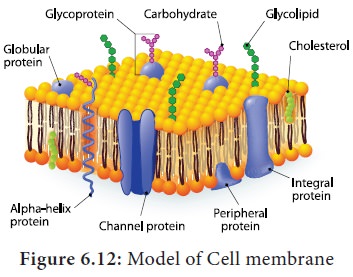
Fluid Mosaic Model
Jonathan
Singer and Garth Nicolson (1972)
proposed fluid mosaic model.
It is made up of lipids and proteins together with
a little amount of carbohydrate. The lipid membrane is made up of phospholipid.
The phospholipid molecule has a hydrophobic tail and hydrophilic head. The
hydrophobic tail repels water and hydrophilic head attracts water. The proteins
of the membrane are globular proteins which are found intermingled between the
lipid bilayer most of which are projecting beyond the lipid bilayer. These
proteins are called as integral proteins.
Few are superficially attached on
either surface of the lipid bilayer which are called as peripheral proteins. The
proteins are involved in transport
of molecules across the membranes and also act as enzymes, receptors (or)
antigens.
The Carbohydrate molecules of cell membrane are
short chain polysaccharides. These are either bound with ‘glycoproteins’ or ‘glycolipids’
and form a ‘glyocalyx’ (Figure
6.12).
The movement of membrane lipids from one side of
the membrane to the other side by vertical movement is called flip flopping or flip flop movement.
This movement takes place more
slowly than lateral diffusion of lipid molecule. The phospholipids can have
flip flop movement because the phospholipids have smaller polar regions,
whereas the proteins cannot flip flop because the polar region is extensive.
Function of Cell Membrane
The functions of the cell membrane is enormous
which includes cell signalling, transporting nutrients and water, preventing
unwanted substances entering into the cell, and so on.
Cell Transport
Cell membrane act as a channel of transport for
molecules. The membrane is selectively permeable to molecules. It transports
molecules through energy dependant process and energy independent process. The
membrane proteins (channel and carrier) are involved in movement of ions and
molecules across the membrane (Figure 6.13).
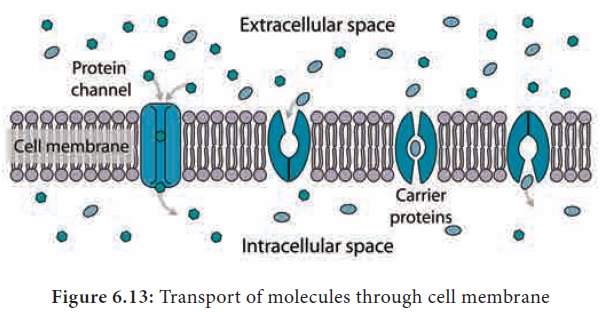
Endocytosis and Exocytosis
Cell surface membrane are able to transport
individual molecules and ions. There are processes in which a cell can
transport a large quantity of solids and liquids into cell (endocytosis) or out of cell (exocytosis) (Figure 6.14).
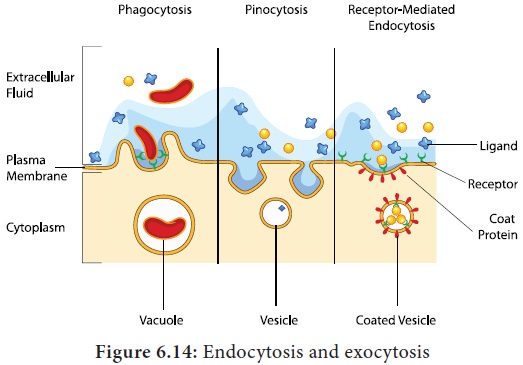
Endocytosis:
During
endocytosis the cell wraps the cell
surface membrane around the material and brings it into cytoplasm inside a vesicle. There
are two types of endocytosis:
1) Phagocytosis – Particle is engulfed by membrane, which folds around it and
forms a vesicle. The enzymes digest the material and products are absorbed by
cytoplasm.
2) Pinocytosis – Fluid droplets are engulfed by membrane, which forms vesicles
around them.
Exocytosis:
Vesicles
fuse with plasma membrane and eject
contents. This passage of material out of the cell is known as exocytosis. This material may be a
secretion in the case of digestive enzymes, hormones or mucus.
Signal Transduction
The process by which the cell receive information
from outside and respond is called signal
transduction . Plants, fungi and animal cell use nitric oxide as one of the
many signalling molecules. The cell membrane is the site of chemical
interactions of signal transduction. Receptors receives the information from
first messenger and transmit the message through series of membrane proteins.
It activates second messenger which stimulates the cell to carry out specific
function.
Cytoplasm
Cytoplasm is the main arena of various activities of a cell. It is the semifluid gelatinous substance that fills the cell. It is made up of eighty percent water and is usually clear and colourless. The cytoplasm is sometimes described as non nuclear content of protoplasm. The cytoplasm serves as a molecular soup where all the cellular organelles are suspended and bound together by a lipid bilayer plasma membrane. It constitutes dissolved nutrients, numerous salts and acids to dissolve waste products. It is a very good conductor of electricity. It gives support and protection to the cell organelles. It helps movement of the cellular materials around the cell through a process called cytoplasmic streaming. Further, most cellular activities such as many metabolic pathways including glycolysis and cell division occur in cytoplasm.
Related Topics